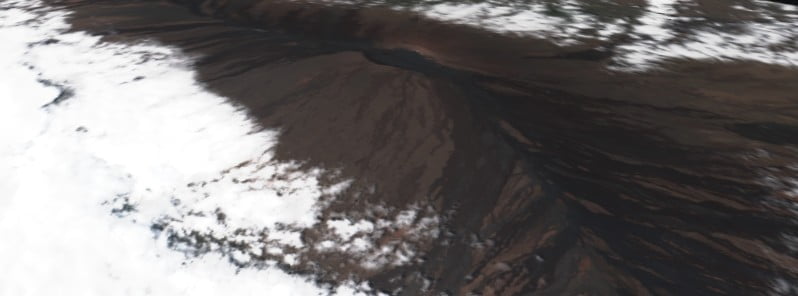Seismic activity beneath Mauna Loa increasing, Hawai’i

Seismic activity beneath the Mauna Loa volcano has been gradually increasing over the past 2 months. In addition, a small seismic swarm started on September 23, with most earthquakes in a cluster about 5 km (3.1 miles) wide and -2 to 1 km (-1.2 to 0.6 miles) below the surface. The Aviation Color Code is at Yellow and the Volcano Alert Level at Advisory.
The swarm started at around 12:30 UTC on September 23. By 20:29 UTC, HVO registered 38 earthquakes beneath the summit caldera region with most earthquakes in a cluster about 5 km (3.1 miles) wide and -2 to 1 km (-1.2 to 0.6 miles) below the surface.1
These earthquakes may result from changes in the magma storage system and/or may be part of normal re-adjustments of the volcano due to changing stresses within it.
“Seismic activity beneath Mauna Loa has been gradually increasing over the past two months,” HVO Scientist-in-Charge Ken Hon said, adding that small earthquake swarms are considered a normal part of this increase in activity.
There are currently no indications that magma is moving toward the surface and other monitoring systems are displaying normal behavior.
Levels of seismicity and deformation remain below those recorded during the winter of 2021.
The last eruption at this volcano lasted from March 25 to April 15, 1984 (VEI 0).
Geological summary
Massive Mauna Loa shield volcano rises almost 9 km (5.6 miles) above the sea floor to form the world’s largest active volcano.
Flank eruptions are predominately from the lengthy NE and SW rift zones, and the summit is cut by the Mokuaweoweo caldera, which sits within an older and larger 6 x 8 km (3.7 x 5 miles) caldera.
Two of the youngest large debris avalanches documented in Hawaii traveled nearly 100 km from Mauna Loa; the second of the Alika avalanches was emplaced about 105 000 years ago (Moore et al. 1989).
Almost 90% of the surface of the basaltic shield volcano is covered by lavas less than 4 000 years old (Lockwood and Lipman, 1987).
During a 750-year eruptive period beginning about 1500 years ago, a series of voluminous overflows from a summit lava lake covered about one-fourth of the volcano’s surface.
The ensuing 750-year period, from shortly after the formation of the Mokuaweoweo caldera until the present, saw an additional quarter of the volcano covered with lava flows predominately from the summit and NW rift zone vents.
This volcano is located within the Hawaiian Islands, a UNESCO World Heritage property.2
References:
1 HAWAIIAN VOLCANO OBSERVATORY INFORMATION STATEMENT – U.S. Geological Survey – Friday, September 23, 2022, 20:29 UTC)
2 Mauna Loa – Geological summary – GVP
Featured image: Mauna Loa on September 19, 2022. Credit: Copernicus EU/Sentinel-2, EO Browser, The Watchers

Commenting rules and guidelines
We value the thoughts and opinions of our readers and welcome healthy discussions on our website. In order to maintain a respectful and positive community, we ask that all commenters follow these rules:
We reserve the right to remove any comments that violate these rules. By commenting on our website, you agree to abide by these guidelines. Thank you for helping to create a positive and welcoming environment for all.